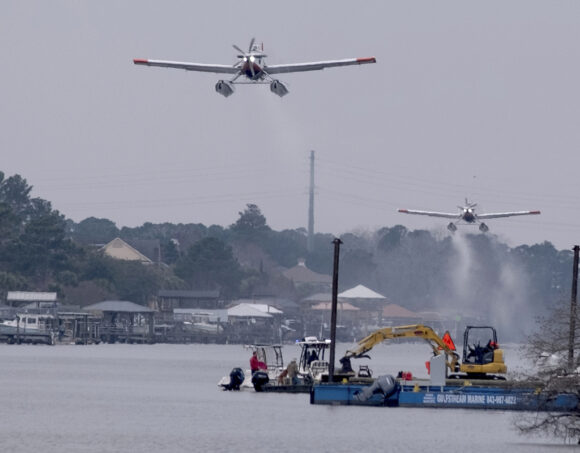Rain in Carolinas May Dampen Wildfires But Threat of Tornadoes, More Fires Looms

The Carolinas saw some much-needed rainfall Wednesday morning, helping to quell wildfires that had burned more than 2,600 acres – but also raising the threat of tornadoes.
Even with the new rainfall, insurance and weather analysts say that fires and fire conditions are becoming more prevalent in the Carolinas and other states far from the historic hot spots in the western United States.
“The fire season, which used to last four months, now often extends to six to eight months, with winter wildfires becoming more common in states such as the Carolinas, New Jersey, New York, California, Arizona, Colorado, New Mexico, Texas and Tennessee,” Firas Saleh, director of wildfire models for North America, at Moody’s, a well-known rating and analytics firm.
Extended drought in the Carolinas and other eastern states, brought on by higher temperatures, have raised the threat of wildfires and highlight the need for more proactive mitigation measures, Saleh said. The biggest risk is in urban areas, where fires can spread from building to building, just as they did in the Los Angeles fires earlier this year. High winds, dry vegetation, flammable building materials, and proximity to vegetation all contribute to this heightened risk, Moody’s noted in an email Wednesday.
So far in 2025, more than 7,100 fires have been reported across the country. That’s 37% higher than the 10-year average for the same January-to-March period, Moody’s, the National Interagency Fire Center and the National Interagency Coordination Center reported.
In western North Carolina, where one fire has burned more than 480 acres, the wildfire threat was exacerbated by vast amounts of dead trees and debris left from Hurricane Helene’s flooding in October, researchers and insurance industry representatives have said. Even though the hurricane brought record rainfall in the region, a lack of significant rain since then has dried out vegetation, a model that could contribute to more fires, according to scientists and news reports.
The largest Carolina fire this week was near the beach city of Myrtle Beach. It was the biggest fire in the area since a 2009 wildfire nearby did $42 million in damage and destroyed about 75 homes, the Associated Press reported.
The fire this week burned 2.5 square miles and was about 30% contained as of Monday evening, according to Horry County Fire Rescue. The department deployed drones as well as ground crews to respond to flare-up fires, reinforce break lines and set up portable sprinkler systems.
The area near Myrtle Beach is now considered one of the most dangerous for wildfires in South Carolina as hundreds of years of decomposing vegetation creates peat, which when it dries out can burn for a long time, the AP noted.
Officials in all of South Carolina banned almost all outdoor fires, including burning yard debris and campfires. They told residents to call 911 if they see a neighbor setting a fire.
“You can and will go to jail for starting a fire outdoors in South Carolina. Period,” Gov. Henry McMaster wrote on social media.
Burn bans were also in place in western North Carolina. Some residents in Polk County remained evacuated from their homes as fire crews Monday morning set their own blazes to burn possible wildfire fuel to make it easier to contain a 480-acre (190-hectare) fire that was about 30% contained.
In eastern North Carolina, nearly 80 smaller wildfires were reported in Robeson County. Emergency officials said 15 structures were damaged, but they did not give specifics on the types of buildings.
The North Carolina Forest Service reported more than 200 wildfires across the state Monday, although almost all of them were small and not threatening any structures.
Meanwhile, a cold front that stretched from the Gulf of Mexico to Canada moved through the Carolinas, bringing heavy rain but also tornado-friendly conditions. The National Weather Service issued a tornado watch until 1 p.m. Wednesday for most counties in eastern South Carolina and a huge swath of middle North Carolina. Officials in north Florida also warned of potential tornadoes as the front moved across the region.
Photo: Planes fill bladders with water near Myrtle Beach this week. (Janet Morgan/The Post And Courier via AP)
Copyright 2025 Associated Press. All rights reserved. This material may not be published, broadcast, rewritten or redistributed.
Topics
Catastrophe
Natural Disasters
Wildfire
Windstorm
Interested in Catastrophe?
Get automatic alerts for this topic.






